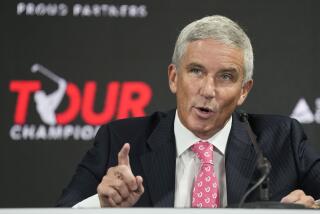He’s Mr. Misunderstood
As Vijay Singh left the putting green to play a practice round at a tournament late in the season, a reporter who has known Singh for years said two words.
“Hello, Veej.”
Singh stopped in his tracks, turned around and said eight words.
“Don’t ever say those words to me again.”
So what was this all about? One word: Annika.
The bottom line is simple, that Singh didn’t like what was written about him and his politically incorrect reaction to Annika Sorenstam’s playing in a PGA Tour event.
But six months later and he’s still steamed?
And six months later, Singh finishes his best year with victories at the John Deere and at the Disney, seconds at the American Express Championship and the Chrysler and a tie for fifth at the Tour Championship.
There is no coincidence working here, only a quick snapshot of a player in transition. If only we knew, from what to what? Better check the clues, because he’s been dropping them all over the place.
The real Vijay saw nothing wrong with his caddie wearing a hat with the message “Tiger Who?” written on it before playing a match with Tiger Woods in the Presidents Cup. Woods never conceded a putt longer than 18 inches and won the match.
The real Vijay is one of the hardest-working players on the PGA Tour, who impresses his peers when he stays on the driving range until darkness chases him away.
The real Vijay was banished from the Asian tour in a doctored-scorecard controversy in 1985.
The real Vijay has victories in two major championships, attained the PGA Tour money title this year when he won four times and produced the best scoring average of his career.
Singh became a poster subject for intolerance when he criticized Sorenstam’s entry at Colonial. Singh is a devoted family man who brings his wife, Ardena, and son, Qass, on as many trips as possible. Singh treats the media with as much contempt as he can get away with and still maintain his status as a member of a PGA Tour that values public relations. Singh is as honest an interview as a reporter could find, on the rare occasions he chooses to be that way.
And so on ...
There’s more, of course, but that’s a brief glimpse of Singh, the 40-year-old from Fiji who didn’t produce a breakthrough year until his 11th season on the PGA Tour.
Some would argue that he already had broken through before, when he won the PGA Championship in 1998 or in 2000 when he won the Masters, but this one was much better ... and infinitely worse at the same time.
It’s popular to say that Singh is misunderstood, that the wide variances in his social skills and his job skills can only lead to such a conclusion. At the same time, there is every indication that Singh is not misunderstood at all. He is merely a complex personality who thrives on adversity, says what’s on his mind and plays golf with a very high level of proficiency.
Sometimes, the message gets lost, usually because Singh dropped it.
For example, he has no problem explaining why he had such a great year.
“Why, maybe because I’ve hit a million balls and because I’ve been out there [practicing] the longest forever and maybe because I’ve just dedicated [myself] and wanted more. I’ve worked hard throughout my career. I’m working hard physically with my golf game and I haven’t slowed down.”
So it’s because he works the hardest and wants it the most. Many top players, beginning with Woods, could take exception to that. As it turns out, Woods falls far short of being a Vijay fan, a stance that began when Singh’s caddie wore that cap at the Presidents Cup. When Woods leaked the information that he had spoken to a player he thought was using a “hot” driver, many assumed he was fingering Singh, although Woods would not confirm it.
In general, Singh is liked well enough in the locker room, if that means anything. Remember, more than one pro wasn’t too thrilled when Woods arrived on the scene in the fall of 1996, accompanied by a crammed bandwagon, hordes of media and a commotion not seen for decades. If Woods was aloof, that’s the worst anyone could say, especially because he began making everyone richer when he started pumping up the tournament purses, from $70.7 million in 1996 to about $235 million in 2003.
But it has been Singh’s rocky relationship with the golf media off the course that may have tarnished his best year on the course.
“Obviously, it’s been a tough relationship,” Jim Furyk said. “Vijay’s very direct, very blunt. If he doesn’t like you, he’ll be more than happy to let you know. He’s not going to shy away from the situation.”
The Sorenstam-Colonial situation was one that Singh should have shied away from, and quickly. Once he said he thought Sorenstam did not belong in a men’s event, that he hoped she would miss the cut and that he would withdraw if paired with her, Singh was roundly criticized. Also, he had provided Sorenstam an even greater forum and a larger stage to be seen and heard.
“He probably said some things that most of us, even if you had felt that way, which I don’t think [we would have said],” Furyk said. “But that’s Vijay’s makeup. He says he won’t shy away from that situation. And if you don’t agree with it, that’s fine. I think he has to accept the consequences.
“There’s a lot of articles out there that are opinion-related. Vijay had his opinion, the writers have their opinion of certain issues and that’s the chance you take.”
Singh’s reaction was to shut the media out, except on rare occasions, such as when he won at Disney and was obligated to speak to the writers. He explained his relationship with the media and why he doesn’t have one.
“I have not had that much problems with fans all my life. With the media, that’s another story. I think the media thinks they control the field and the fan rides on that. You just have to go back and see a few months ago. Everything was fine until the controversy came on and then the media kind of gets into the play. It’s those things that kind of hurt me. If it hurts me, it hurts you guys too, because I will not talk to you guys if that’s the case.
“I just can’t trust what you’re going to write. It’s been going on forever, it’s not only with me, but it’s with other sports. And you keep reading it over and over again, what the media writes is not what the people say, and that’s it.”
At the Nelson tournament two days later, Singh said he had been misquoted about Sorenstam. Singh said he wanted her to miss the cut in case he missed the cut himself, because he didn’t want to be beaten by a woman.
Doug Ferguson of Associated Press, who had reported Singh’s comments about Sorenstam, reviewed his notes and stood by his story.
Singh was so upset by the entire controversy, he shot four rounds in the 60s and won the Nelson. It was one of four tournaments Singh won in 2003, when he led the PGA Tour with 18 top 10s and won the money title with $7.57 million, about $900,000 more than Woods, who had won it the previous four years.
Singh moved to second in the world ranking behind Woods, ranked sixth in driving distance at 301.9 yards, was second to Woods in scoring with a career-best 68.65 average, second in birdies, third in consecutive cuts with 21 (every one after the Players Championship in March), 12th in greens in regulation and 18th in putting.
And, Singh moved up to third on the all-time money list with $25.8 million, behind only Woods and Davis Love III.
That’s a long way from the time Singh spent in Borneo, where he taught lessons for $10 after losing his playing privileges on the Asian Tour when he was accused of changing his scorecard in a tournament.
Singh has long insisted that incident, which has dogged him for nearly two decades, was a misunderstanding. Call it a contradiction, a factual conflict, a set of circumstances that didn’t add up. Misunderstandings of all sorts have been Singh’s constant companion. Maybe, after what happened this year, now that it’s all out in the open, we don’t have to say that anymore.
More to Read
Go beyond the scoreboard
Get the latest on L.A.'s teams in the daily Sports Report newsletter.
You may occasionally receive promotional content from the Los Angeles Times.










